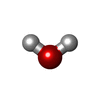+ データを開く
データを開く
- 基本情報
基本情報
| 登録情報 | データベース: PDB / ID: 9buz | ||||||
|---|---|---|---|---|---|---|---|
| タイトル | Thermoplasma acidophilum 20S proteasome - alphaV24Y | ||||||
 要素 要素 |
| ||||||
 キーワード キーワード | HYDROLASE / Protease / threonine protease / endopeptidase activity | ||||||
| 機能・相同性 |  機能・相同性情報 機能・相同性情報proteasome endopeptidase complex / proteasome core complex, beta-subunit complex / threonine-type endopeptidase activity / proteasome core complex, alpha-subunit complex / proteasomal protein catabolic process / ubiquitin-dependent protein catabolic process / endopeptidase activity / cytoplasm 類似検索 - 分子機能 | ||||||
| 生物種 |   Thermoplasma acidophilum (好酸性) Thermoplasma acidophilum (好酸性) | ||||||
| 手法 | 電子顕微鏡法 / 単粒子再構成法 / クライオ電子顕微鏡法 / 解像度: 2.38 Å | ||||||
 データ登録者 データ登録者 | Chuah, J. / Smith, D. | ||||||
| 資金援助 |  米国, 1件 米国, 1件
| ||||||
 引用 引用 |  ジャーナル: bioRxiv / 年: 2025 ジャーナル: bioRxiv / 年: 2025タイトル: Occupancy of the HbYX hydrophobic pocket is sufficient to induce gate opening in the archaeal 20S proteasomes. 著者: Janelle J Y Chuah / Madalena R Daugherty / David M Smith /  要旨: Enhancing proteasome function has been a long-standing but challenging target of interest for the potential treatment of neurodegenerative diseases, emphasizing the importance of understanding ...Enhancing proteasome function has been a long-standing but challenging target of interest for the potential treatment of neurodegenerative diseases, emphasizing the importance of understanding proteasome activation mechanisms. Most proteasome activator complexes use the C-terminal HbYX (hydrophobic-tyrosine-almost any residue) motif to bind and trigger gate-opening in the 20S proteasome. This study defines a critical molecular interaction in the HbYX mechanism that triggers gate opening. We focus on the Hb site interaction and find it plays a surprisingly central and crucial role in driving the allosteric conformational changes that induce gate opening in the archaeal 20S. We examined the cryo-EM structure of two mutant archaeal proteasomes, αV24Y T20S and αV24F T20S. These two mutants were engineered to place a bulky aromatic residue in the HbYX hydrophobic pocket; both mutants are highly active, though their mechanisms of activation are undefined. Collectively, our findings indicate that the interaction between the Hb group of the HbYX motif and its corresponding hydrophobic pocket is sufficient to induce gate opening in a mechanistically similar way to the HbYX motif. The activation mechanism studied here involves the expansion of the hydrophobic binding site, allosterically altering the state of the IT switch thus triggering gate-opening. Furthermore, we show that the canonical αK66 residue, previously understood to be critical for proteasome activator binding, also plays a key role in stabilizing the open gate, irrespective of activator binding. This study differentiates between the residues in the HbYX motif that support binding interactions ("YX") versus those that allosterically contribute to gate opening ("Hb"). The insights reported here will guide future drug development efforts, particularly in designing small molecule proteasome activators, by targeting the identified hydrophobic pocket. | ||||||
| 履歴 |
|
- 構造の表示
構造の表示
| 構造ビューア | 分子:  Molmil Molmil Jmol/JSmol Jmol/JSmol |
|---|
- ダウンロードとリンク
ダウンロードとリンク
- ダウンロード
ダウンロード
| PDBx/mmCIF形式 |  9buz.cif.gz 9buz.cif.gz | 2.1 MB | 表示 |  PDBx/mmCIF形式 PDBx/mmCIF形式 |
|---|---|---|---|---|
| PDB形式 |  pdb9buz.ent.gz pdb9buz.ent.gz | 1.8 MB | 表示 |  PDB形式 PDB形式 |
| PDBx/mmJSON形式 |  9buz.json.gz 9buz.json.gz | ツリー表示 |  PDBx/mmJSON形式 PDBx/mmJSON形式 | |
| その他 |  その他のダウンロード その他のダウンロード |
-検証レポート
| 文書・要旨 |  9buz_validation.pdf.gz 9buz_validation.pdf.gz | 1.6 MB | 表示 |  wwPDB検証レポート wwPDB検証レポート |
|---|---|---|---|---|
| 文書・詳細版 |  9buz_full_validation.pdf.gz 9buz_full_validation.pdf.gz | 1.6 MB | 表示 | |
| XML形式データ |  9buz_validation.xml.gz 9buz_validation.xml.gz | 153.3 KB | 表示 | |
| CIF形式データ |  9buz_validation.cif.gz 9buz_validation.cif.gz | 218.2 KB | 表示 | |
| アーカイブディレクトリ |  https://data.pdbj.org/pub/pdb/validation_reports/bu/9buz https://data.pdbj.org/pub/pdb/validation_reports/bu/9buz ftp://data.pdbj.org/pub/pdb/validation_reports/bu/9buz ftp://data.pdbj.org/pub/pdb/validation_reports/bu/9buz | HTTPS FTP |
-関連構造データ
| 関連構造データ |  44926MC C: 同じ文献を引用 ( M: このデータのモデリングに利用したマップデータ |
|---|---|
| 類似構造データ | 類似検索 - 機能・相同性  F&H 検索 F&H 検索 |
- リンク
リンク
- 集合体
集合体
| 登録構造単位 | 
|
|---|---|
| 1 |
|
- 要素
要素
| #1: タンパク質 | 分子量: 25893.490 Da / 分子数: 14 / 変異: V24Y / 由来タイプ: 組換発現 / 由来: (組換発現)   Thermoplasma acidophilum (好酸性) / 遺伝子: psmA, Ta1288 / 発現宿主: Thermoplasma acidophilum (好酸性) / 遺伝子: psmA, Ta1288 / 発現宿主:  #2: タンパク質 | 分子量: 23169.811 Da / 分子数: 14 / 由来タイプ: 組換発現 / 由来: (組換発現)   Thermoplasma acidophilum (好酸性) / 遺伝子: psmB, Ta0612 / 発現宿主: Thermoplasma acidophilum (好酸性) / 遺伝子: psmB, Ta0612 / 発現宿主:  #3: 水 | ChemComp-HOH / | Has protein modification | N | |
|---|
-実験情報
-実験
| 実験 | 手法: 電子顕微鏡法 |
|---|---|
| EM実験 | 試料の集合状態: PARTICLE / 3次元再構成法: 単粒子再構成法 |
- 試料調製
試料調製
| 構成要素 | 名称: Thermoplasma acidophilum 20S proteasome alphaV24Y / タイプ: COMPLEX / Entity ID: #1-#2 / 由来: RECOMBINANT |
|---|---|
| 分子量 | 値: 700 kDa/nm / 実験値: NO |
| 由来(天然) | 生物種:   Thermoplasma acidophilum (好酸性) Thermoplasma acidophilum (好酸性) |
| 由来(組換発現) | 生物種:  |
| 緩衝液 | pH: 7.4 |
| 試料 | 濃度: 1 mg/ml / 包埋: NO / シャドウイング: NO / 染色: NO / 凍結: YES |
| 急速凍結 | 凍結剤: ETHANE |
- 電子顕微鏡撮影
電子顕微鏡撮影
| 実験機器 |  モデル: Titan Krios / 画像提供: FEI Company |
|---|---|
| 顕微鏡 | モデル: TFS KRIOS |
| 電子銃 | 電子線源:  FIELD EMISSION GUN / 加速電圧: 300 kV / 照射モード: FLOOD BEAM FIELD EMISSION GUN / 加速電圧: 300 kV / 照射モード: FLOOD BEAM |
| 電子レンズ | モード: BRIGHT FIELD / 最大 デフォーカス(公称値): 2400 nm / 最小 デフォーカス(公称値): 1200 nm |
| 撮影 | 電子線照射量: 50 e/Å2 / 検出モード: SUPER-RESOLUTION フィルム・検出器のモデル: FEI FALCON III (4k x 4k) |
- 解析
解析
| EMソフトウェア |
| |||||||||||||||
|---|---|---|---|---|---|---|---|---|---|---|---|---|---|---|---|---|
| CTF補正 | タイプ: PHASE FLIPPING AND AMPLITUDE CORRECTION | |||||||||||||||
| 3次元再構成 | 解像度: 2.38 Å / 解像度の算出法: FSC 0.143 CUT-OFF / 粒子像の数: 396542 / 対称性のタイプ: POINT | |||||||||||||||
| 原子モデル構築 | プロトコル: FLEXIBLE FIT |
 ムービー
ムービー コントローラー
コントローラー




 PDBj
PDBj




